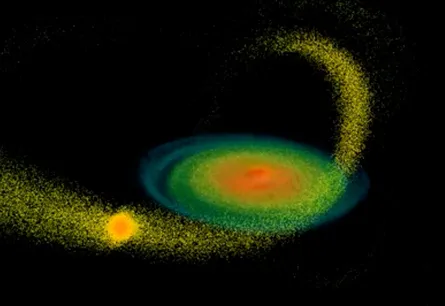Atom & Cosmos
The source of the Milky Way’s spirals, a new way to spot gravitational waves and more in this week’s news
Galactic close encounter
The Milky Way should have ducked: Some 1.75 billion years ago a smaller galaxy swung by our neck of the cosmic woods, smearing out the Milky Way’s stars in a gravitational tug-of-war. Astronomers have simulated this galactic close encounter in the best detail yet, and suggest that it may have formed the Milky Way’s dramatic spiral arms. Small-galaxy interactions could thus play a bigger role in shaping galaxies than previously thought, write Chris Purcell, of the University of Pittsburgh and the University of California, Irvine, and his colleagues in the Sept. 15 Nature. —Alexandra Witze

Putting the squeeze on gravitational waves
Making a deal with a quantum devil could help researchers detect gravitational waves — hypothetical ripples in the fabric of spacetime caused by supernovas, black holes and other massive, accelerating objects. These ripples are so slight that they can be hidden by random quantum fluctuations in the laser beams designed to detect them. But squeezed light — an unusual state that trades certainty about light’s amplitude for certainty about its phase — can suppress this randomness. Adding squeezed light to the GEO600 detector near Hannover, Germany, reduced noise in the detector, improving its sensitivity to high-frequency gravitational waves by more than a factor of three, researchers estimate online September 11 in Nature Physics. —Devin Powell
Primitive galaxies glow blue
The universe’s first galaxies may glow with an identifiable bluish light. These galaxies should contain exemplars of the first population of stars, those made of only hydrogen and helium. Such stars produce a great deal of energy capable of ionizing hydrogen, but the resulting blue-tinged emission tends to be lost in dusty intervening material. Swedish and Japanese astronomers now suggest September 9 on arXiv.org that this emission can actually be spotted by the Hubble Space Telescope, allowing astronomers to identify the first galaxies in the early universe. Indeed, they note, objects have already been sighted that match their criteria.—Camille M. Carlisle
A 21st century Gemini mission
NASA’s latest lunar explorers — the GRAIL mission’s twin spacecraft — took to the heavens on September 10. As they zoom around the moon in a shared orbit, the twins will measure the moon’s gravity and interior structure. Mountains, craters and subterranean masses all tug slightly on the craft and vary the distance between them. Instruments capable of detecting changes in the separation of the pair as small as the width of a red blood cell will use these fluctuations to create the gravity map. —Nadia Drake
Black holes blocked
Though supermassive black holes are notorious light-killers, there might be another reason they’re hard to see: The fractured remnants of comets and asteroids that once lived near the black holes form a dusty debris disk that’s hard to see through. These terrestrial bodies create a Super-Oort cloud lurking near active galactic nuclei, a team of astronomers suggests in a paper posted online September 6 at arXiv.org. Areas surrounding the dark, feisty feasters are known to be metal-rich, fertile star-forming grounds. The team suggests that giant planets and terrestrial bodies might also take shape near the vortex — as these smaller bodies collide, they could produce the occluding cloud. —Nadia Drake
Supernova surprise
PTF 11kly, the recently discovered type 1a supernova, is already changing what scientists know about these types of stellar explosions, which result from overstuffed white dwarf stars. After searching archival Hubble Space Telescope images, astronomers were unable to find the supernova progenitor’s mug shot. Now, a team suggests in a study posted to arXiv.org on September 7 that the star was 10 to100 times fainter than expected. This means that the white dwarf’s companion — the star it stole matter from until it popped — was almost certainly not a regular middle-aged star. Instead, scientists think the dwarf may have been joined by a second dwarf or a small, cool star. —Nadia Drake







